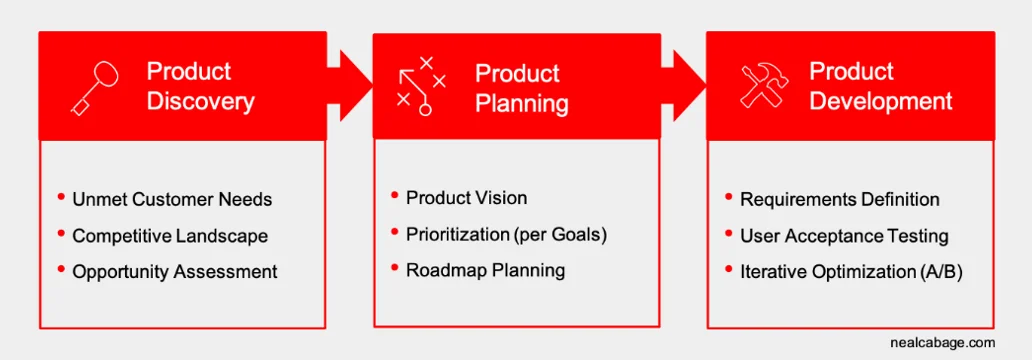Product Management’s Role in Software: A Fool’s Game or an Evolving Adventure?
Nearly 30,000 new physical consumer products are introduced each year, and 95 percent of them fail. And no business is immune to this harrowing statistic, including software, where close to 85 percent of big data software projects fail. Of those software projects that are not canceled, many software products are delivered late or suffer from quality and security issues. Product managers face many challenges, and the odds of success are slim. Amidst such cloudiness and odds, wouldn’t it be a fool’s game to be responsible for a product’s ultimate success or failure?
As a technologist who first experienced the challenges of the role many years ago working on a digital services team in the automotive industry, I now find myself mentoring others as they try to navigate the demands and expectations of the product manager role within software-enabled systems. I see that customers are not investing enough resources, time, and effort in product management. Due to lack of understanding of product management responsibilities, they mistakenly interchange the role with project and program management. Due to lack of resources, they dual hat the role with other roles, such as a business analyst, systems analyst, or senior engineer. The problem is that product management, technology, and process are the legs of the three-legged stool of Agile product delivery. They exist on a level plane, and if one leg is weak, the final product suffers. The final product, if delivered, may be suboptimal, may not meet its intended goals, or may not be accepted by end users.
Job titles aside, to build a successful product you do need context, business savvy, domain knowledge, vision, customer empathy, technical prowess, communication skills, and leadership. While Agile approaches, such as Scrum and SAFe, focus on the mechanics of the product manager role, this blog focuses on the origins and intentions behind product management because understanding one’s purpose is a key enabler to success. Moreover, this blog will show how traditional product management activities are necessary for software products, though software development requires additional unique considerations. Not only is product management essential to launching a successful product, but it can be a key differentiator in a competitive space.
Types of Product Managers
While every organization is different, Adobe recently defined the five most popular types of product management roles:
- Product manager. The product manager owns the entire product lifecycle from start to finish. They are more concerned with product concepts and will then pass the project to the product owner to execute the project. Product managers work with both internal and external stakeholders. They are also responsible for the product vision, including success metrics, return on investment, and successful launch and adoption.
- Product owner. The product owner specializes in developing and executing the product. This is an internal-facing role that collaborates with developers, designers, and the product manager. The product owner will also look at the product backlog to determine what the team should build next.
- Growth product manager. The growth product manager works with leadership, sales, marketing, and accounting to improve product key performance indicators (KPIs). They are mostly focused on revenue, lifetime value, and customer retention.
- Technical product manager. The technical product manager focuses on product specifications and functionality. This is a technical role that works closely with the engineering and development teams to ensure product concepts are technically feasible.
- Platform product manager. The platform product manager looks at the organization’s software platform as a whole. They are largely responsible for optimizing the product’s platform to enable and improve the user experience.
The Origins of Product Management
On May 13, 1931, Neil H. McElroy, an advertising executive at Procter & Gamble responsible for the Camay soap brand, drafted a business memo about the intention to grow his brand management team. What started out as a justification to hire more people shaped the direction of modern brand management and set in motion what would ultimately become product management. In his 800-word memo, McElroy introduced the concept of Brand Men, a team that took absolute responsibility for a brand from tracking sales to managing product, advertising, and promotions.
McElroy prescribed novel activities including “studying past performance to uncover weaknesses, experimenting, developing a plan and applying treatments” by physically being out in the field rather than sitting behind a desk in the office. McElroy ultimately gained his two hires, and Procter & Gamble subsequently restructured into a brand-centric organization. More importantly, the product manager role was introduced in the consumer-packaged goods industry.
As an advisor at Stanford University, McElroy’s thought leadership shaped the trajectory of two young entrepreneurs named Bill Hewlett and David Packard. They interpreted the Brand Man ethos as putting decision-making as close as possible to the customer and making the product manager the voice of the customer internally. In The HP Way: How Bill Hewlett and I Built Our Company, David Packard describes how “making a technical contribution and meeting customer needs” was foundational in the vision and culture at Hewlett-Packard.
Meanwhile across the Pacific Ocean, Toyota had developed a just-in-time automotive manufacturing production system called the Toyota Production System (TPS). TPS is an integrated sociotechnical system that optimizes just-in-time auto manufacturing using lean principles to reduce waste. It includes interactions with workers, technology, suppliers, and customers. Also ingrained in the Toyota way are the concepts of kaizen (Japanese to English translation: good change), which stresses continuous improvement of the business, and genchi genbutsu (translation: go look, go see), which emphasizes going to the source to find facts rather than making assumptions. These two ideas reflect a commitment to meeting the ever-changing needs of your customer, whether it be an internal customer (e.g., a design team handing off designs to an engineering team) or external customer (e.g., a consumer taking possession of a new car).
From Hewlett-Packard to Toyota, this new way of thinking—brand vertical, customer centric, and lean manufacturing—resonated in business communities. These ideas helped solidify the importance of product management throughout the product lifecycle, from concept inception to product production to delivery to the customer.
The friction between marketing and product management teams can still be felt in many organizations today. Both may feel that they own the customer and understand the marketplace. In most tech organizations, however, marketing has evolved to be more about owning the brand messaging and customer acquisition, while product management owns the value proposition and the development of the product.
Connecting Product Management, Products, and the Product Manager Role
Product manager is a strategic role within an organization that deals with developing and bringing products to the market. The role is fundamentally focused on delivering value to customers through the delivery of products, arguably some more useful than others. A product can be a physical item, software, or service designed to satisfy the needs of a group of users. The product lifecycle spans all phases, from development and introduction to the market through retirement when the product is no longer needed.
At its core, product management is about solving the needs of users and doing so in a way that can be produced at scale, so customers receive increasing value compared to their cost. The product manager’s responsibility is to deeply understand the needs of users and identify the opportunities in the market where value can be created. Product management oversees the creation and refinement of this product over time so that maximum value is being created for customers as well as for the business.
On a daily basis, product managers evaluate the following:
- What problems are the customers having?
- What problems are worth solving and why?
- How do we solve them?
Product managers look to answer these questions based on the following key concepts.
- Maximum business value is realized by focusing on creating value for customers. This is the founding strategy upon which product management is based.
- Product managers fundamentally serve the customer, not internal stakeholders. In defining the product, they talk directly to the customers to obtain firsthand information as discussed earlier.
- Their focus is on understanding and measuring the market and customer needs, not navigating internal organizational systems.
- Product–market fit is the top priority, not speed of delivery. Hence, the product manager role is different from the project manager or scrum master role.
Three Pillars of Product
A product manager creates value by informing and directing activities within the product lifecycle, from idea generation and verification to planning, developing, and launching a product. As illustrated in the figure below, product strategy thought-leader Neal Cabage has broken the product lifecycle into three main stages: Product Discovery, Product Planning, and Product Development. These stages are a useful reference for understanding how product managers lead throughout the product lifecycle.

Product Discovery
How is it possible that only 5 percent of new products survive? Svafa Grönfeldt, faculty member for MIT Professional Education, writes, “Many innovations fail because they introduce products or other solutions without a real need for them. There’s no market for the solutions they’ve created.” Many organizations do not take their customers’ needs into account when launching their products. “Some of these failures arise from a lack of empathy on the part of the organization, with those in decision-making positions not taking the necessary time to study and understand the customers’ true needs. Without putting themselves in their shoes, it’s often too late when they realize there’s no market for their solutions.”
During product discovery, product managers mine for new opportunities by assessing the competitive landscape and identifying unmet customer needs. Product discovery is both a brainstorming and research activity aimed at identifying opportunities to create customer value. It is likely to be a series of nonlinear activities conducted by a cross-functional team. Various stakeholders meet to discuss what product and features should be built in service of the customer. The product discovery process guides product development teams to find the right problems to solve for the customers. It also ensures that teams avoid wasting time and company resources in attempting to serve the wrong customers, solve the wrong issues, or build the wrong solutions.
“At its core, Product Discovery is the evidenced-informed process of reducing uncertainty as you find problems worth solving and solutions worth building,” writes product management coach Tim Herbig. Herbig encourages product managers to ask the following questions to see how well a team understands its problem space:
- What are the three pieces of first-hand evidence that support the notion that this problem is worth solving?
- When was the last time you had valid interactions with users from your target audience?
- Can you name the specific changes in behavior your user would have to adopt so that they can achieve their goals and make progress?
- Do you have quantitative and qualitative insights into the problem?
After the team has identified potential problems to solve, the next step is to research how to solve them. For the management of software products, it is important to take the assessment of the opportunity further by answering preliminary questions about feasibility and scope.
- What technologies do you need to build the solution?
- What scope of work is required to be successful?
Including technologists in your discovery efforts allows for quick feasibility discussions within the context of the problem. Moreover, bringing developers in the problem context firsthand encourages developer empathy for the users so that their decisions result in a better product.
Product Planning
During product planning, product managers spend a considerable amount of time crafting a long-term product vision and developing and maintaining a roadmap. These two strategic outputs of product planning serve as the basis for feature prioritization and later inform the tactical aspects of product development. Like many other strategic efforts, putting significant energy into these efforts up front enhances the viability of the product later.
After customer requirements analysis and validation, the product team creates a product roadmap that prioritizes the major topics to be addressed. This roadmap serves as a blueprint for the execution of the action plan going into product development. Preliminary scheduling addresses milestones and defined targets. Milestones may include a prioritization of features or batching of specific feature groups to support a specific capability. Defined targets may include building prototypes or a minimum viable product (MVP). In summary, the focus of this phase should be on delivering value and responding to product goals. Meeting these goals should be measured against key indicators rather than by calendar dates.
Moreover, for the management of software products, the enabling functions of the software development lifecycle should be taken into consideration during product planning. Enablers such as architecture, infrastructure, compliance, and security, bring visibility to all the work necessary to support the efficient development and delivery of future business requirements. While it is not intended for a product design to be fully fleshed out at this phase, it is important to establish a high-level strategy. Additional activities to consider include the software delivery and update strategy, testing and user acceptance plan, product launch (phased or staggered based on some criteria), and user training and support.
Product Development
Product development is the phase in which the organization produces a tangible product. Product management has created a list of features to build. Each feature is composed of requirements and acceptance criteria. These features are prioritized in a product backlog, and from this backlog the highest priority items are translated to work-tasks for development teams, who then turn ideas into working product. A significant part of the software product development process is product design. During the design stage of product development, technical architects produce the organized software architecture that fulfills the specified project criteria and requirements. This stage is where the real conceptualization of the software begins to take shape.
Different products will require different product development processes, but there are some foundational steps that most software development projects require for a successful launch. The team will decide on common software development process methodologies, such as Agile software development, continuous integration, and incremental development. Programming is a complex process, so it is recommended to test new code often and regression test an entire suite of code at product milestones. Lastly, before a software product is released, user acceptance testing should be completed and launch activities that include user training and support should be planned. Educating users helps them use new software effectively and increases the likelihood of successful product adoption. Where the product is software, or software is an enabler of the product, the activities in the software development process must be included within the scope of the product lifecycle.
The Evolving Future of Product Management
Just as software is playing a greater role in products, product management is having a greater influence in organizational strategy. Good product management is not only an advantage to the success of the product, but it is becoming a sustainable competitive advantage for organizations that do it well. As a result of this, product management has moved out of the marketing and engineering teams and is increasingly getting a seat at the management table, reporting directly to the CEO.
Raising the visibility and impact of product management is critically important because it aligns the product team directly with the organizational vision and goals. This alignment allows the product management team to serve as an amplifying force to evangelize that vision both internally and externally. It provides them with the visibility and leverage necessary to make tough priority decisions and to set product and organizational direction, all in service of solving the right problem in the right way for the intended customer.
Additional Resources
The SEI has conducted research on Agile software approaches in the Department of Defense and other government settings since 2009. To read more on this topic, please visit https://insights.sei.cmu.edu/blog/topics/agile/.
While there is no definitive textbook for technical product management, there are some very well regarded books on the subject, including the following:
- Inspired: How to Create Tech Products Customers Love by Marty Cagan
- The Product Book by Josh Anon and Carlos González de Villaumbrosia
- The Lean Product Playbook: How to Innovate with Minimum Viable Products and Rapid Customer Feedback by Dan Olsen
More By The Author
More In Software Engineering Research and Development
PUBLISHED IN
Get updates on our latest work.
Sign up to have the latest post sent to your inbox weekly.
Subscribe Get our RSS feedMore In Software Engineering Research and Development
Get updates on our latest work.
Each week, our researchers write about the latest in software engineering, cybersecurity and artificial intelligence. Sign up to get the latest post sent to your inbox the day it's published.
Subscribe Get our RSS feed
